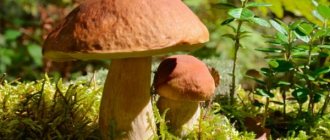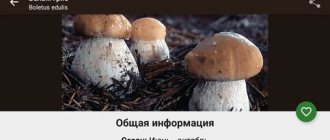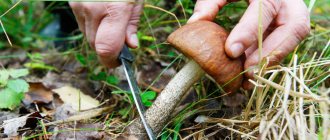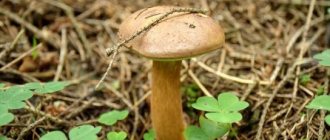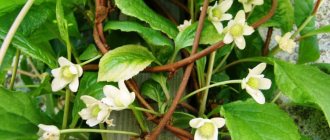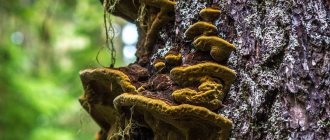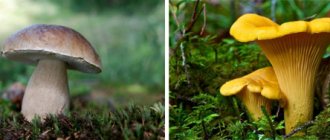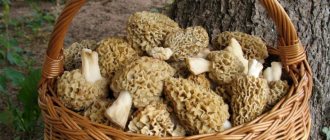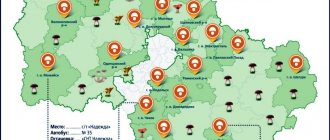Inedible and edible mushrooms of the Voronezh region are represented by a very large number of species. This region is located in the forest-steppe zone, where more than five hundred species of mushrooms grow. Quite often, inexperienced mushroom pickers go to collect unfamiliar mushrooms that can pose a potential danger to life and health. To eliminate the risk of poisoning, you need to familiarize yourself with the description of edible species, and also learn to distinguish them from poisonous or toxic mushrooms.
Distribution locations and timing of mushroom collection in Bashkiria
The Bashkir region is rich in its natural gifts, because there are many fruitful places just for picking mushrooms. Among them, experienced lovers of quiet hunting highlight forest belts located in close proximity to the villages of Kushnarenkovo and Kamyshly, entire tracts of the Blagovarsky and Duvansky districts, plantings near Mesyagutovo, the Ozernaya and Yam-Bakhta railway stations, as well as green areas near Zaton, Nurlino , Ishkarovka and Dmitrievka.
You may be interested in: What is the difference between edible talkers and false mushrooms? How many days after rain do mushrooms grow? Bittersweet mushroom: photo and detailed description Some mushroom pickers have their own secret places, which they are in no hurry to reveal for obvious reasons, while others, on the contrary, organize group trips , teaching the difficult science of gathering. Be that as it may, there really are a lot of mushrooms in Bashkiria, and their long fruiting season allows you to always return from the forest with a full basket.
Thus, the first mushrooms begin to appear in mid-April, while cold-resistant varieties can continue to grow even at the end of October. So-called winter mushrooms, such as tinder fungi, are also found in the republican forests, however, they are not eaten, most often finding other uses for the fruits (traditional medicine, etc.) and other inedible or even poisonous specimens.
Mushroom places of the Rostov region
Throughout the Rostov region, mushrooms are especially common - there is soil suitable for them and a good climate. But in certain places, mushroom hunting can be especially successful. First of all, this includes:
- Millerovsky district, especially around the village of Dyogtevo, pine plantings of the city of Millerovo;
- districts of the city of Kamensk-Shakhtinsky;
- Chertkovsky district;
- there are quite a lot of different mushrooms in the pine plantations of the Nizhnekundryuchenskaya village;
- Tarasovsky district;
- Semikarakorsky district;
- coastal zone of the Don;
- Shchepkinsky forest in Rostov-on-Don.
First spring edible mushrooms
The mushroom season can begin in early spring, producing the first tiny caps on the surface of the earth in late March or early April. The soil is the last to revive in the northern regions of the republic, where fruits appear no earlier than the middle or even the end of May.
Morels
The morel is rightfully considered one of the earliest inhabitants of the forest, because its wrinkled brown cap can often be seen breaking through right from under the melted snow. Despite its substantial size, which can vary from 5 to 30 cm, the fruit body is particularly light.
Stitches
The closest relative of morels is the string, although its edibility is conditional. The bizarre forms of representatives of this species, growing mainly under coniferous trees, immediately attract the attention of forest visitors.
At the same time, their bright caps, which usually do not exceed 10 cm in diameter, can be consumed only after triple processing, which involves prolonged soaking in a weak brine and boiling in two waters with the obligatory addition of spices.
Polypores
Tinder fungi growing directly on tree trunks are attractive. For their bright yellow color and delicate soft consistency, reminiscent of a fluffy omelette, mushroom pickers nicknamed the variety witch’s dough. It is noteworthy that these mushrooms can only be eaten when they are still loose and soft, since as they grow older they become too hard, losing their edible qualities.
Collection rules
To the great regret of all connoisseurs of quiet hunting, doctors categorically do not recommend collecting mushrooms in the Rostov region , since climatic conditions can make even mushrooms traditionally classified as edible potentially dangerous.
In the Rostov region, there is a tendency to increase the natural gamma background, so quiet hunting has lost a little of its former popularity. However, when collecting, be sure to adhere to the following simple recommendations:
- refuse to collect mushrooms during periods that are too dry;
- the most suitable time for picking mushrooms is the morning;
- You cannot pull out the fruiting bodies of mushrooms from the soil; it is best to cut them off with a knife or twist them without damaging the mycelium;
- do not collect wormy or overgrown fruiting bodies;
- do not collect unknown types of mushrooms, even if their fruiting bodies have a pleasant mushroom aroma;
- the fruiting bodies of milkweeds and russula must be boiled or soaked before cooking, which will remove bitter components from them that have a harmful effect on the gastrointestinal tract;
- Before cooking, morel fruiting bodies must be boiled for a quarter of an hour, followed by disposal of the broth.
Description of summer mushrooms of Bashkiria
In summer, the season gains momentum and in green spaces you can find an increasing number of tasty and nutritious mushrooms of different varieties. All of them are good in their own way, except for the presence of dangerous doubles, which are found in almost every edible variety.
Yellow boletus
In the forests of Bashkortostan you can see a variety of mushroom in which the cap, the stem, the hymenophore, and even the flesh have a uniform yellow color. This variety differs from the usual porcini mushroom and is more modest in size, having a cap up to 5 cm in diameter and a tuberous stalk, the thickness of which can range from 4 to 12 cm.
Chanterelles
Chanterelles are quite common and very recognizable forest inhabitants, often found in Bashkir green areas. Small, neat mushrooms are funnel-shaped, rich yellow or orange-brown, and exude a slightly acidic aroma.
They usually grow in whole groups, choosing for this the open edges of coniferous and mixed forests. Mushroom pickers are also attracted by the fact that these fruits are almost never affected by worms and other forest parasites.
Boletus
Despite its name, this mushroom grows not only under aspens, but also under many other representatives of deciduous trees, found mainly in the southern part of the republic. Large, stately, with a massive cap, this forest dweller is easily identified thanks to its dark scales on a stalk that thickens downwards.
Duboviki
In Bashkiria there are at least two types of oak trees: common and speckled. The first of them has a brighter reddish-brown leg, while the second is completely covered with red speckles. Both mushrooms have yellow flesh, which always turns green when broken.
Mokhoviki
Among the distinctive characteristics of these mushrooms are a velvety, often slightly cracked chocolate cap with a maximum diameter of 9 cm and a tubular hymenophore, somewhat reminiscent of a miniature foam sponge. The flesh of the mushroom is white, however, upon contact with the air, it tends to turn yellow, red or even blue.
Svinushki - mushrooms similar to milk mushrooms
The debate about the edibility of pig mushrooms was stopped in the early 90s, when all types of these mushrooms were officially recognized as dangerous to human life and health. Some mushroom pickers continue to collect them for food to this day, but this should not be done under any circumstances, since pig toxins can accumulate in the body and symptoms of poisoning do not appear immediately.
Externally, poisonous mushrooms are similar to milk mushrooms: they are small, with squat legs and a fleshy round cap of a dirty yellow or gray-brown color. The center of the hat is deeply concave, the edges are wavy. The fruit body is yellowish in cross section, but quickly darkens from the air. Pigs grow in groups in forests and plantings; they especially love wind-fallen trees, located among their rhizomes.
There are more than 30 varieties of pig's ear, as the mushroom is also called. All of them contain lectins and can cause poisoning, but the thinnest pig is considered the most dangerous. The cap of a young poisonous mushroom is smooth, dirty olive, and becomes rusty over time. The short leg has the shape of a cylinder. When the mushroom body is broken, a distinct smell of rotting wood is heard.
The following pigs are no less dangerous:
- Alder. The cap is brown-yellow with small scales, the edges are slightly pubescent, the funnel is small. The leg is short, tapering downward.
- Fat. The velvety brown cap is quite large and tongue-like. The stem is a little fleecy and is almost always attached not in the center, but closer to the edge of the hat. The pulp is watery, odorless.
- Ear-shaped. The small leg merges with a hard fan-shaped cap of dark yellow color with a brown tint. Grows on conifer stumps and logs.
Names of autumn varieties of mushrooms in Bashkiria
The main mushroom season starts at the end of August or beginning of September, continuing until the second or third ten days of October. This season is usually accompanied by a lot of rainfall and high humidity levels.
Volnushka
Despite the fact that these small mushrooms with a mucous convex cap of a soft pink color, which tends to flatten out as they grow older, belong to the category of conditionally edible, many connoisseurs know a lot about their preparation.
Among the distinctive features of the moth are the development in a moist, slightly acidic substrate, the formation of a mucous coating and characteristic spots on it, the appearance of a cavity inside the stem at the stage of aging of the fruiting body, as well as the milky juice it secretes, which does not smell or change color when in contact with the air.
Mokrukha spotted
This variety is capable of producing truly rich harvests. The fruits of mokrukha have a grayish-brown cap with a sparse and thick lamellar layer, covered with mucus. The stem of fungi can completely match the color of their top or be a tone lighter than it.
Variegated umbrella
The scaly brown-white fruit with a wide umbrella cap and a thin curved leg is the closest relative of the common champignon, having an almost identical taste. The umbrella is conditionally edible and is boiled in two waters before being used for food.
Butter
It is quite easy to recognize this inhabitant of coniferous forests thanks to its slimy shiny cap of a brown or red hue. In addition, boletus has a smooth brown-brown leg with a whitish “skirt”.
You can collect mushrooms from early spring until the end of autumn. But the best taste and subtle aroma, reminiscent of raw wood, are possessed by those fruits that were cut in August-September.
Description of edible species
Mushroom pickers in Ufa find in the nearby forests a wide variety of edible species that are suitable for frying, boiling or pickling. They vary by season.
Spring mushrooms
With the onset of stable warmth, after good spring rains, after about a week, the first mushrooms appear in the forest. Their choice is not very rich, but these are the first messengers.
But, nevertheless, Ufa mushroom pickers are happy to collect the following species:
- waves;
- morels;
- tinder fungi;
- morel caps;
- raincoats;
- rows.
These firstborns of spring diversify the menu well and add minerals and vitamins, which are especially necessary for the human body after a long winter.
Spring in Ufa will delight mushroom pickers with morels
There are several types of morels near Ufa: ordinary and conical. The conical morel has a cone-shaped cap and is gray in color. The leg is completely white, but fragile and hollow. And the common one has a cellular and brown cap. It is fused with a white leg, which also has folds. Both species are found in forests and clearings, sometimes growing along highways.
Morel caps have a different appearance. The surface of the cap is wrinkled and yellow. The hats are held on tall creamy stems. They form mycorrhiza with birch and other deciduous trees.
Polypores are parasitic fungi; both gray and variegated ones are found in Ufa forests. The gray variety has a round, yellowish cap. It rests on a soft, hollow leg. The height of which can reach up to 10 cm.
Variegated polypores have yellow, scaly caps with a brown tint. The leg matches the hat, low and wide. Polypores grow on tree trunks, often on deciduous trees.
Summer mushrooms
In summer, the weather in Ufa and its surrounding area is often warm and pleasant. It rains as much as is needed to collect good harvests of summer mushrooms.
Local mushroom pickers at this time of year often collect the following species:
- white and semi-white;
- oak trees;
- meadow champignons;
- green moss mushrooms;
- chanterelles;
- red boletuses;
- Dubrovnik.
The noblest and most delicious specimen is the porcini mushroom.
It is good to fry, and to prepare for future use, and to dry, and to freeze, and to salt. Everyone wants to find this “king of the forest.” It cannot be confused with other species. Only if with poisonous natural “counterfeits” (bilious and satanic).
The white one has a thick cylindrical leg, a large dense cap, and is brown or beige in color. The pulp is aromatic and the taste is pleasant. The size of the cap is from 10 to 20 cm, growing up to 25 cm in height. Sometimes there are simply gigantic individuals. But the younger ones taste better. They are less likely to be damaged by harmful insects, which also like to feast on delicious forest “meat”. White and half-white are more common where there are many oak trees, in groves or mixed forests.
Oak trees have lemon-yellow flesh. When cut, it changes color and acquires a grayish tint. Mushrooms grow on fertile soils in mixed forests.
Forest champignons are much tastier than store-bought ones and their aroma is stronger - this is reality. Therefore, they strive to collect them regularly. Good mushroom spots remain constant for many years.
Green moss caps attract the eye with their beautiful suede cap with olive color. Interestingly, their legs are always crooked. And sophisticated to the hat. The color of the stem is usually yellowish or brownish-green. You need to look for moss mushrooms under fallen leaves in mixed forests.
Red-headed boletuses are visible from afar. They are impossible to miss. The caps peek out from under the foliage and from a distance look like precious stones. Many good gathering spots can be found in aspen groves.
But Dubrovnik is more difficult to find. They are hiding in the grass. Light brown caps serve as good camouflage. They have a mesh on the white stem, which serves as a signal that this is an edible mushroom and can be taken. It is best to look for this species in oak groves or pine forests.
Chanterelles are great for making flavorful soups or for pickling. They have beautiful yellow-orange caps, concave inward and wavy at the edges. Their shape resembles a funnel for water. The leg of chanterelles is small, up to 6 cm. It is hollow inside and fragile. The shape of the leg is cylindrical. The pulp is aromatic and pleasant to the taste. Chanterelles grow in birch groves or mixed forests.
Autumn mushrooms
Saffron milk caps attract attention with their color
It is very pleasant to wander through the forest in warm autumn weather. Such a walk can relax you, improve your mood, and you will most likely pick up a lot of mushrooms.
The most popular autumn species that grow near Ufa include:
- saffron milk caps;
- waves;
- real milk mushrooms;
- honey mushrooms;
- valui;
- boletus;
- spotted moth.
It is impossible to pass by a saffron milk cap in a coniferous forest. Its orange cap is clearly visible under the fallen needles. The shape of the cap is convex or resembles a funnel. The stem is low, up to 8 cm. The aroma is pleasant and characteristic. The pulp is fragile. In deciduous forests they are found up to Pokrov.
Traditionally, September has a good harvest of honey mushrooms. To search, you will have to climb deeper into the thicket, where there are fallen trees and mossy stumps. For mushrooms, it is better to take large, ventilated baskets with you. Because they grow in groups and, having found such a family, you can gain several kilograms at once. Mushroom sites usually do not change for many years, unless the mycelium is damaged. It is better to cut off only the caps. Legs are of no use. They taste watery, hard and hollow. Honey mushrooms are found in deciduous and mixed Ufa forests until frosts and the first snow.
Irina Selyutina (Biologist):
If you want to harvest a good harvest of honey mushrooms, you will have to walk through a forest that is more than 30 years old. It is in such a forest that you can find plenty of favorite places for honey mushrooms - rotten stumps, fallen rotting trunks or tree roots, dead wood.
It is best to collect honey mushrooms, like other mushrooms, in the early morning, because that is when they will be the freshest and most dense after the cool of the night and, importantly, are more resistant to long-term transportation and storage.
By the way. Autumn honey mushrooms settle on 200 species of plants, both woody and herbaceous. However, most often they can be found in damp dark forests on the stumps of elm, aspen, birch or alder. Collected from the end of August until the beginning of winter, if the air temperature is kept at +10℃.
You can look for boletus (aspen and boletus) until the end of leaf fall, as long as there is cover on the trees, this species will delight its admirers.
In the first autumn month, the mass collection of milk mushrooms begins. And it continues until mid-October. These mushrooms are well salted. Their caps are large and yellow-cream in color. They have characteristic circles in the center. The shape of the leg is conical. The consistency is dense. A white milky juice is released at the fracture. It has a bitter taste. To get rid of the unpleasant aftertaste, milk mushrooms must be soaked in cold water for several hours before the main cooking.
What edible mushrooms are collected in September?
And September mushrooms are especially good - fragrant, bright, shiny from condensation formed as a result of temperature changes. It is during this period that the largest harvests can be harvested, the fruiting of which is facilitated by the climatic conditions of the region.
Honey mushrooms
A distinctive feature of honey mushrooms is their growth on stumps and old wood, where these small fungi form entire colonies. The color of their cap can be of different shades, depending on the characteristics of the nutrient medium. Thus, in nature there are honey mushrooms of pale brown, red, honey and even olive shades, young specimens of which are considered a real delicacy.
Rogatiki
In the Bashkir forests and deciduous forests you can find a huge number of all kinds of hornets, the main distinguishing characteristic of which is an elongated coral-like fruiting body. These mushrooms have a fragile, watery structure, more suitable for marinades and pickles than for classic frying in a pan.
Saffron milk caps
This variety has a rich orange cap, owing its brightness to the high content of beta-carotene in the fruit body. But the list of beneficial properties of the mushroom does not end there, because it is not without reason that its nutritional properties are practically not inferior to chicken, veal and egg yolk. As for collecting saffron milk caps, it is better to go to the forest after heavy rains, as they are moisture-loving.
Milk mushrooms
Finding milk mushrooms is not so easy, because they are accustomed to hiding under a dense layer of fallen leaves and dead wood, forming entire settlements in such shelters. Among the main features of the species are dense white pulp, secreting milky juice, and a delicate fruity aroma.
How to process mushrooms (video)
https://www.youtube.com/watch?v=5jNXQjoi8QE
The May mushroom is especially popular in the Rostov region, mass fruiting of which occurs on St. George's Day. Young fruiting bodies have a hemispherical or round shape, but with age the marginal part acquires characteristic waviness and a relatively slight bend towards the top. The coloring of the fruiting bodies is predominantly yellowish-white. Fruiting bodies grow en masse in fairly large groups in open forests and park grass, in gardens and vegetable gardens, as well as along forest edges.
Inedible and poisonous mushroom species of Bashkiria
Unfortunately, inedible varieties of mushrooms are found in Bashkortostan as often as edible ones. Among the dangerous species most often found in the region, we should highlight the pale toadstool, which is rightfully considered the most poisonous mushroom, easily causing death even in minimal doses, the less lethal red fly agaric and the sulfur-yellow honey agaric.
Poisonous grass and some other false varieties that can cause harm of varying degrees of severity also grow here. We should not forget that the region has a developed petrochemical industry.
Note!
It is important to remember that all mushrooms, without exception, have the ability to absorb substances emitted into the atmosphere during harmful production, gradually increasing their concentration.
That is why it is forbidden to harvest crops near such places, so as not to put your health at serious risk. For the same reason, those mushrooms that grow on the sides of busy highways are also considered dangerous, because accumulated elements from exhaust gases can cause poisoning.
Poisonous umbrellas
Slender mushrooms on tall, thin stalks with flat, wide-open caps resembling an umbrella grow in abundance along roads and roadsides. They are called umbrellas. The cap actually opens up and becomes wider as the mushroom grows. Most varieties of umbrella mushrooms are edible and very tasty, but there are also poisonous specimens among them.
The most dangerous and common poisonous mushrooms are the following umbrellas:
- Comb. The reddish flat cap of an adult mushroom has a slight convexity in the center. The entire surface is covered with sparse orange scales, similar to scallops, and there is a light fringe along the edge. The stem is hollow, thin, yellowish in color; in young mushrooms it is ringed, but the ring quickly breaks.
- Chestnut. It is distinguished by a darker, almost brown, color of the cap and a large number of pronounced scales, also dark in color. The long leg with reddish flesh has a similar color.
